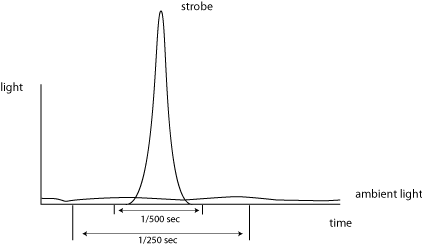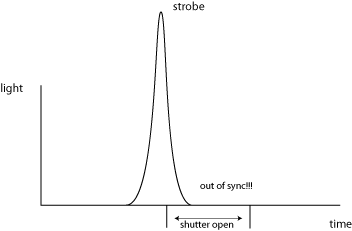- Strobes/Measuring Light:
- The burst of light from strobe is very brief. You cannot measure
(or see) the amount of light accurately without a flash meter.
- Ambient light

- With strobe/flash

Shutter speeds become insignificant when light from the strobe
dominates ambient light. As long as shutter speed is slower than the
strobe light (usually slower than a 500th of a sec should be safe),
ambient light will not register in studio setups where you have powerful strobes.
In the example above,
- f2.8 at 1/500th a sec
- f2.8 at 1/250th a sec
will most likely yield a similar picture.
- Synchronizing:
- Synchronizing the strobe to the camera/shutter -- you have to make
sure you have the strobe go off when the shutter is fully open.
Most cameras will have an indicator that tells you which shutter speeds synchronizes with flash/strobes. Too fast a shutter speed will not sync with flash/strobes.
- Out of sync:

Synchronization is accomplished using sync cables or radio
controlled transmitters and receivers.
- Multiple Light Source:
- If you can afford long exposures:
- Set your scene and measure strobe (eg. f 22 -- at this point
you have enough light from the strobe to shoot at f 22 at 500th or
anything slower).
- Then measure ambient light w/o the strobe at f 22. See what the
exposure time is (eg. 1 sec).
- If you shoot f 22 at 1 sec with strobe + ambient light, this will
give you equally balanced lighting from both light sources. If you
shoot at .5 sec at f 22 ambient light will be a stop darker then the
strobe.
- Note that long exposure creates color shifts, not to mention motion blurs in the area exposed by ambient light.
Area illuminated by strobe will remain sharp without motion blur.
- If you cannot afford long exposure
- Measure ambient light (eg. f2.4 at 1/60th) .
- Reduce power of strobe to the f stop that matches measurement of ambient light (eg. f2.4).
(for example, indirectly bouncing light off walls.)

- Modeling/shaping light
- Grid, Snoot, Umbrella, Softbox...etc
Warning:
these units carry power and can be dangerous. Read the
instructions if uncertain. Some common safety precautions -- Do not
use it near water. Turn the power pack unit off before plugging in
cables. Discharge the power pack with a test button after you turn the
pack off.



